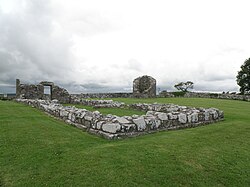Among Patrick’s first converts were Bronagh, daughter of Milchu, and her son Mochaoi (Mahee), whose birthname was Caolàn. St Mochaoi was to found the great monastery of Nendrum on Mahee Island in Loch Cuan (Strangford Lough), and is associated with the saint in the legends which grew around Patrick’s name. These legends firmly place Down as the cradle of Christianity in Ireland. Patrick himself is said to have founded Armagh around 444, and the selection of a site so close to Emain Macha would strongly suggest that the Ulster capital was still the most powerful over-kingdom in Ireland at that time. Furthermore, dendrochronology has dated a tide milll on Mahee island to the year 619, making this one of the oldest excavated tide mills anywhere in the world. The monastery came to an end at some time between 974 and 1178, but its church served a parish until the site was abandoned in the 15th century. Some remains of the monastery can still be seen.
But of all the stories told in the old books of Ireland the most strangely beautiful is that of the Bird of Heaven… Now the story of the Bird of Heaven is this: Mahee was the first man to whom Patrick gave a gospel. And so it was that the grandson of Milchu gathered around him young men to build a church of wood in the manner of the people of Ulster. And as he was about to rest after cutting his portion of timber, “He heard a bright bird singing on the blackthorn near him.” This bird was more beautiful than all the birds of the world and Mahee, greatly moved by its song, listened enthralled. “And the bird said “Surely this is diligent work, O Holy man’ “.The young man was astonished to hear the bird of such wonderful song speak to him in human words and he said, “Who can thus address me?” And the bird immediately replied, “A man of the people of my Lord,” which is to say, an Angel of God from Heaven. “All hail to Thee,” said Mahee with awe, “and wherefore hast thou come hither?” “I am here by command to address thee from my Lord, that I may encourage thee in thy good work, but also because of the love in my heart for thy Lord Jesus to amuse thee for a time with my sweet singing.” “I am glad of that,” said the young man.
Then suddenly the bird took his beak from his wing and Mahee heard no more his perpetual praise. So the Angel bade him farewell. When the bird was gone Mahee lifted his timbers and made for home as in a dream. And in amazement he looked at that place he head that long left; for there he found a church already built. And a man strange to him passed and told him that this was the church of St Mahee. Then Mahee spoke to the children of God within, but they knew him not, “Tell us your name and lineage,” they inquired, and he said to them, “I am Mahee, son of Bronagh, daughter of Milchu the King.” And he told them his tale and they all knew him and knelt to him. And they made a shrine of the wood, and afterwards built a great church at that place. “And surpassingly white Angels often alighted there, or sang hymns to it from the branches of the forest trees, or leaned with their foot on tiptoe, their eyes on the horizon, their ear to the ground, their wings flapping, their bodies trembling, waiting to send tidings of prayer and repentance with a beat of their wings to the King of the Everlasting.”
It is written that twice was Mahee Abbot of Nendrum. And that little island in Strangford Lough, anciently known as Nendrum and which lies seven miles south-east of the village of Comber and 16 miles from Belfast, is now called Mahee Island and is surely a holy place. There were many who thought that Mahee was dead when he was seen no more by his fellow monks in the forest of Nendrum in Ulster. But at first it was written:
“A sleep without decay of the body,
Mahee of Nendrum slept;
Of the people of the congregation where the Sage was
He did not find the great-great-grandchildren.
Three melodies of delightful music
The angel, in the shape of a bird, sang,
In the middle of a wood, at the foot of a tree,
Fifty years each melody lasted.”
It may only be a story that the song of the Angel of God was sung to Mahee, and that there were two persons of that name, but the truth is that there arose at that place a great monastery of Nendrum. Here was educated Colman who was of the same people of Mahee, the Cruthin of Ulster. Colman was to found the great school of Dromore, but first at Nendrum itself he helped to educate Finnian or Uinnian, British Uinniau (495-589 AD) who travelled first to Candida Casa and then to Rome, whence he returned to his native land with the first complete copy of St Jerome’s Vulgate version of the Bible. He also founded at Movilla, outside Newtownards in County Down, another great school, the most famous of pupil of which was St Columba, the Light of the Celtic West. Finnian is said to have been of the Dal Fiatach, and thus could be described as Irish, British or both. But one of those who helped Columba in his mission among the Picts or Cruthin of Alba (modern Scotland) was a man, definitely of the Ulster Cruthin, the Ancient British Pretani, whose name was Comgall.
To be continued
© Pretani Associates 2014
